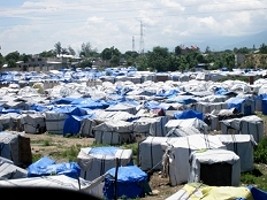|
||||||||||||||||||
|
|
Haiti - Social : Over 60,000 people still living in camps 11/04/2016 09:14:22
The affected communes housing the IDP population are mostly located in the metropolitan area of Port-au-Prince. These are the communes of Carrefour, Port-au-Prince, Delmas, Cite Soleil, Petion-Ville, Tabarre and Croix-des-Bouquets, as well as the communes situated in the Palms Regions, such as Leogane (considered the epicenter of the earthquake) and Gressier. The communes of Jacmel, Petit-Goâve and Grand-Goâve in the Palm Regions and Ganthier in the border region formerly housed IDP sites which have since closed. As of 31st March 2016, the three (3) communes with the highest IDP population are the following : 1. Delmas, with the highest population of IDP households with 10,278 households (60.0% of the total households), corresponding to 32,904 individuals (52.6% of IDP individuals). 2. Croix-des-Bouquets, the second largest with 2,487 households (14.5% of IDP households), corresponding to 10,838 individuals (17.3% of IDP individuals). It is important to note that the households residing in the camps known as Corail Sector 3 and Sector 4 are also included in the commune of Croix-des-Bouquets. 3. Léogâne, the third largest commune, with 1,163 households (7.7% of IDP households), corresponding to 4,801 individuals (8.0% of IDP individuals). These three communes (Delmas, Croix-des-Bouquets and Léogâne) account for 81.4% of the IDP household population displaced by the 2010 earthquake. The remaining communes in the metropolitan area of Port-au-Prince (including Carrefour, Cite Soleil, Pétion-ville, Tabarre,and Port-au-Prince) house 3,026 households (representing 13,370 individuals) and combined, account for 17.7% of all displaced households. In the Palms regions, the communes of Leogane and Greasier, house 1,328 households (representing 5,478 individials) and combined account for 7.8% of all displaced households. As of 31st March 2016, 36 sites remain open in Haiti. As of this period, Delmas and Leogane host the highest share of the IDP sites, with 9 open sites each (25.0% of the total of open sites each). They are followed by Tabarre with 6 open sites (16.7% of total of open sites). Combined, these three communes account for 56.7% of all open sites. Of the 36 open sites, 18 are categorized as tent sites (50.0%). One site is composed of mixed shelters, accounting for 2.8% of all sites. The remaining 17 sites consist of mostly Transitional Shelters (>60%) which makes up 47.2% of all open sites. When comparing the figures from the 25th round of the DTM to the IDP figures from 2010, a net decrease of 343,398 of the total households (or 1,473,857 individuals) identified in 2010, can be observed. Furthermore, this also represents a decrease of 1,519 sites compared to July 2010, during the height of the internal displacement in Haiti. In this report, an additional 3,457 households and 6,340 individuals were included into the DTM figures. This increase is directly correlated to the incorporation of more precise IDP data gathered through the registration operations of three (3) camps (Acra Sud, Acra Cite Nord Del 33 and Village AFCA II). Consequently, when comparing to the previous DTM release (December 2015), the number of households and individuals residing in IDP camps has increased, althought the number of opened camps has decreased. Throughout this reporting period, on-going support through cash grant programs (relocation through rental assistance) have assisted a total of 991 households or 3,318 individuals. The camp Centre d'Hebergement de Galette Greffin was closed and 26 households and 123 individuals were assisted through relocation programs during the period covered by this DTM report. Subsequently, by the end of the current DTM reporting period, the number of IDP sites has been reduced by 1, which has been closed through the return program. Since July 2010, the number of IDP sites has decreased by 97.7% while the IDP household population has decreased by 95.3%. However compared to the previous DTM report published in December 2015, the number of households has increased by 2,440 (or 16.6%) and the number of individuals has increased by 2,870 (or 4.8%). During this reporting period, 1 camp has been reported as closed, whereby a total of 26 households (representing 123 individuals) were relocated through the return program. Furthermore, there were no evictions during this round of DTM assessments. Of the 1,555 IDP sites and 361,517 households identified at the height the displacement crisis in July 2010, 542 sites have been closed through return subsidy programs (corresponding to 81,967 households or 276,519 individuals’ relocated to better housing). Since 2010, a total of 14,444 households were evicted from 176 sites. Meanwhile, 251,444 households (or 1,143,108 individuals) have spontaneously left sites, resulting in the closure of 801 sites. Since 2010, 81,967 households have left camps through rental subsidy programs, leading to the closure of 542 sites. HL/ HaitiLibre
|
|
|
Why HaitiLibre ? |
Contact us |
Français
Copyright © 2010 - 2024 Haitilibre.com |



